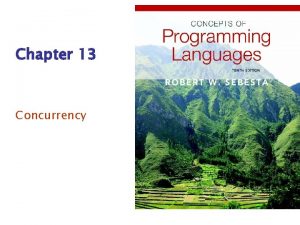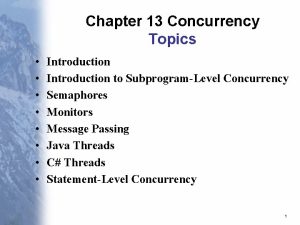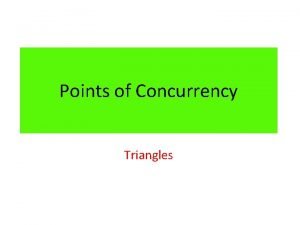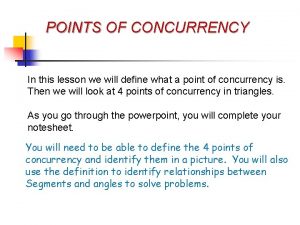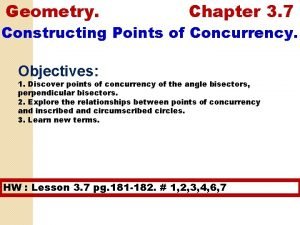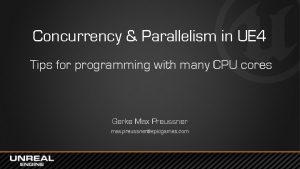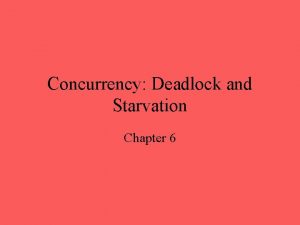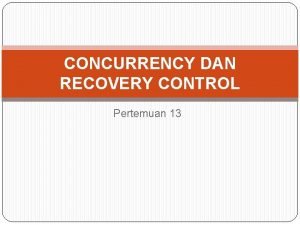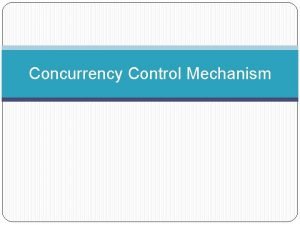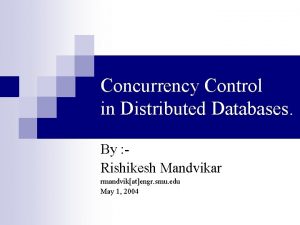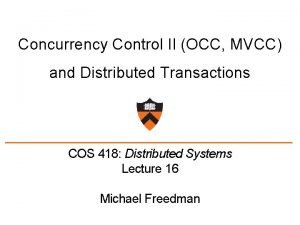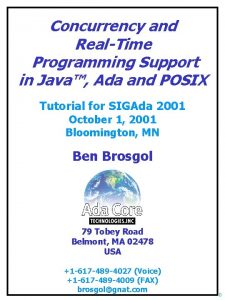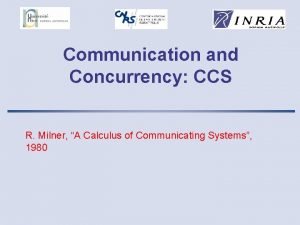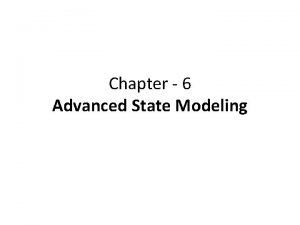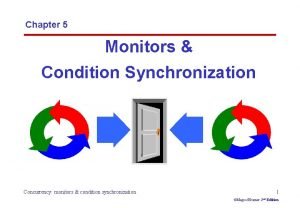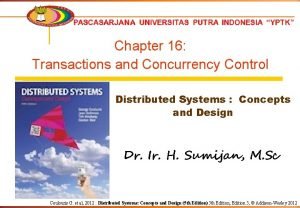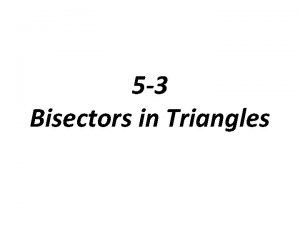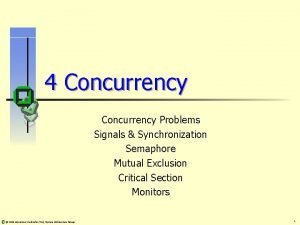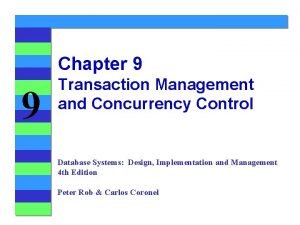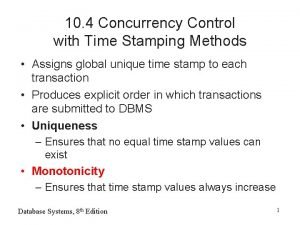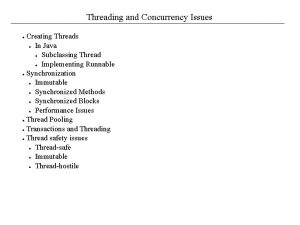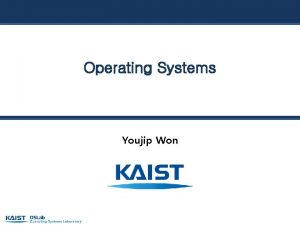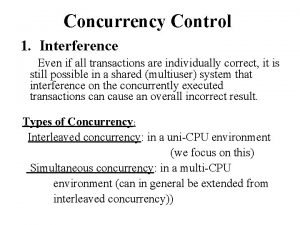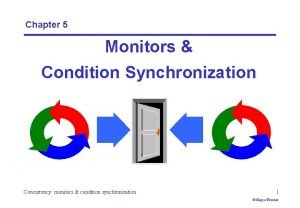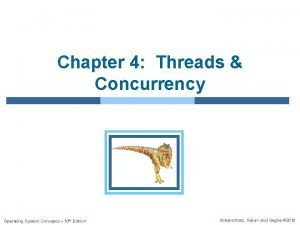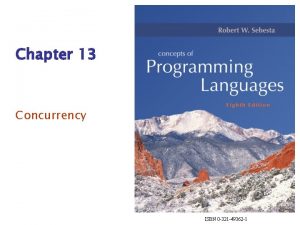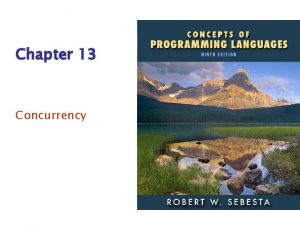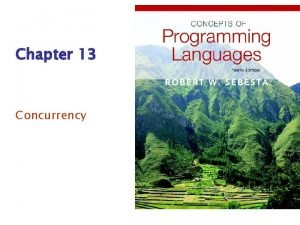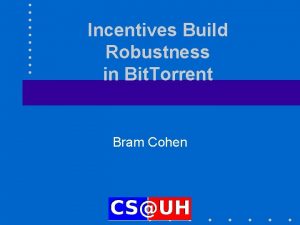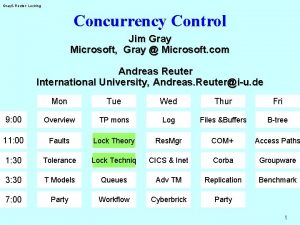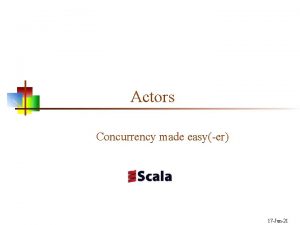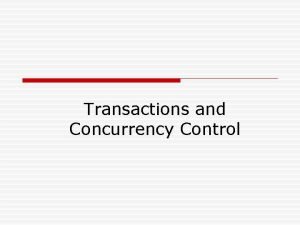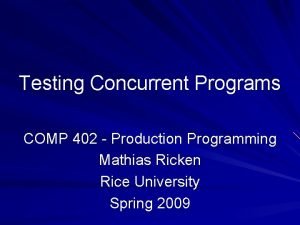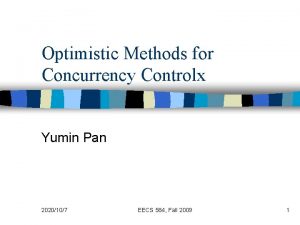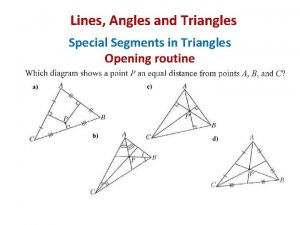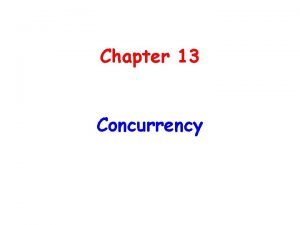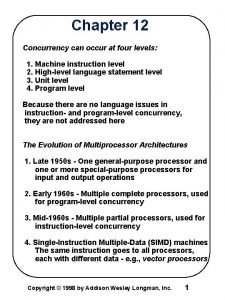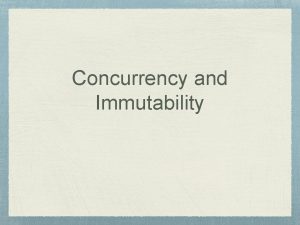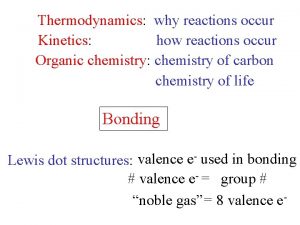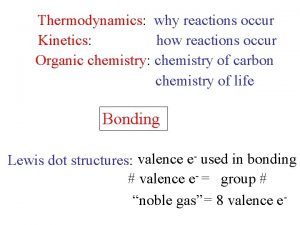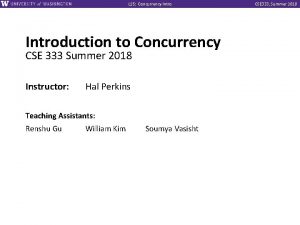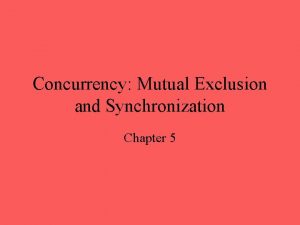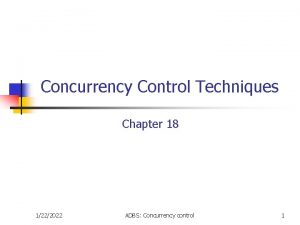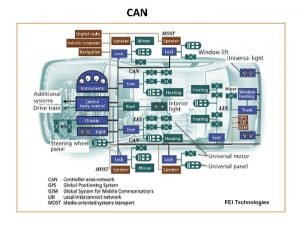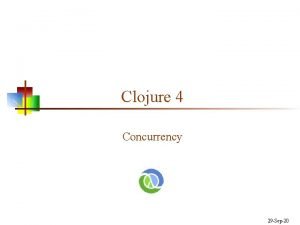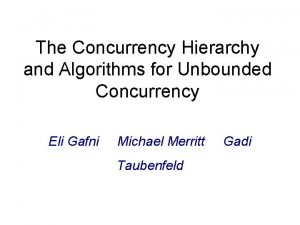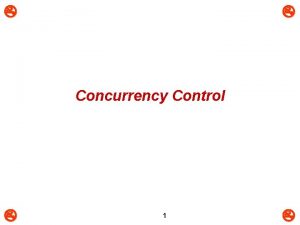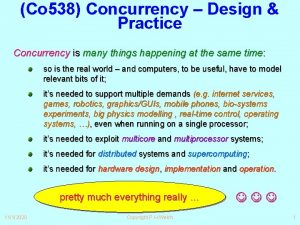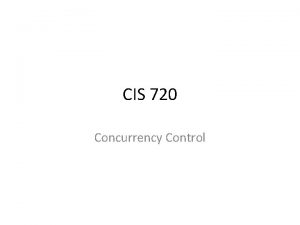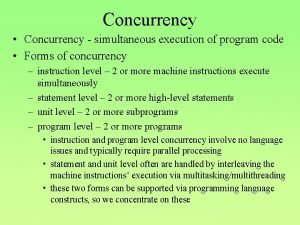Chapter 13 Concurrency Introduction Concurrency can occur at



















































- Slides: 51

Chapter 13 Concurrency

Introduction • Concurrency can occur at four levels: – – Machine instruction level High-level language statement level Unit level Program level • Because there are no language issues in instruction- and program-level concurrency, they are not addressed here Copyright © 2012 Addison-Wesley. All rights reserved. 1 -2

Categories of Concurrency • Categories of Concurrency: – Physical concurrency - Multiple independent processors ( multiple threads of control) – Logical concurrency - The appearance of physical concurrency is presented by timesharing one processor (software can be designed as if there were multiple threads of control) • Coroutines (quasi-concurrency) have a single thread of control • A thread of control in a program is the sequence of program points reached as control flows through the program Copyright © 2012 Addison-Wesley. All rights reserved. 1 -3

Motivations for the Use of Concurrency • Multiprocessor computers capable of physical concurrency are now widely used • Even if a machine has just one processor, a program written to use concurrent execution can be faster than the same program written for nonconcurrent execution • Involves a different way of designing software that can be very useful—many real-world situations involve concurrency • Many program applications are now spread over multiple machines, either locally or over a network Copyright © 2012 Addison-Wesley. All rights reserved. 1 -4

Introduction to Subprogram-Level Concurrency • A task or process or thread is a program unit that can be in concurrent execution with other program units • Tasks differ from ordinary subprograms in that: – A task may be implicitly started – When a program unit starts the execution of a task, it is not necessarily suspended – When a task’s execution is completed, control may not return to the caller • Tasks usually work together Copyright © 2012 Addison-Wesley. All rights reserved. 1 -5

Two General Categories of Tasks • Heavyweight tasks execute in their own address space • Lightweight tasks all run in the same address space – more efficient • A task is disjoint if it does not communicate with or affect the execution of any other task in the program in any way Copyright © 2012 Addison-Wesley. All rights reserved. 1 -6

Task Synchronization • A mechanism that controls the order in which tasks execute • Two kinds of synchronization – Cooperation synchronization – Competition synchronization • Task communication is necessary for synchronization, provided by: - Shared nonlocal variables - Parameters - Message passing Copyright © 2012 Addison-Wesley. All rights reserved. 1 -7

Kinds of synchronization • Cooperation: Task A must wait for task B to complete some specific activity before task A can continue its execution, e. g. , the producer-consumer problem • Competition: Two or more tasks must use some resource that cannot be simultaneously used, e. g. , a shared counter – Competition is usually provided by mutually exclusive access (approaches are discussed later) Copyright © 2012 Addison-Wesley. All rights reserved. 1 -8

Scheduler • Providing synchronization requires a mechanism for delaying task execution • Task execution control is maintained by a program called the scheduler, which maps task execution onto available processors Copyright © 2012 Addison-Wesley. All rights reserved. 1 -9

Task Execution States • New - created but not yet started • Ready - ready to run but not currently running (no available processor) • Running • Blocked - has been running, but cannot now continue (usually waiting for some event to occur) • Dead - no longer active in any sense Copyright © 2012 Addison-Wesley. All rights reserved. 1 -10

Liveness and Deadlock • Liveness is a characteristic that a program unit may or may not have - In sequential code, it means the unit will eventually complete its execution • In a concurrent environment, a task can easily lose its liveness • If all tasks in a concurrent environment lose their liveness, it is called deadlock Copyright © 2012 Addison-Wesley. All rights reserved. 1 -11

Design Issues for Concurrency • Competition and cooperation synchronization* • Controlling task scheduling • How can an application influence task scheduling • How and when tasks start and execution • How and when are tasks created * The most important issue Copyright © 2012 Addison-Wesley. All rights reserved. 1 -12

Methods of Providing Synchronization • Semaphores • Monitors • Message Passing Copyright © 2012 Addison-Wesley. All rights reserved. 1 -13

Semaphores • Dijkstra - 1965 • A semaphore is a data structure consisting of a counter and a queue for storing task descriptors – A task descriptor is a data structure that stores all of the relevant information about the execution state of the task • Semaphores can be used to implement guards on the code that accesses shared data structures • Semaphores have only two operations, wait and release (originally called P and V by Dijkstra) • Semaphores can be used to provide both competition and cooperation synchronization Copyright © 2012 Addison-Wesley. All rights reserved. 1 -14

Producer and Consumer Tasks semaphore fullspots, emptyspots; fullstops. count = 0; emptyspots. count = BUFLEN; task producer; loop -- produce VALUE –wait (emptyspots); {wait for space} DEPOSIT(VALUE); release(fullspots); {increase filled} end loop; end producer; task consumer; loop wait (fullspots); {wait till not empty}} FETCH(VALUE); release(emptyspots); {increase empty} -- consume VALUE –end loop; end consumer; Copyright © 2012 Addison-Wesley. All rights reserved. 1 -15

Competition Synchronization with Semaphores • A third semaphore, named access, is used to control access (competition synchronization) – The counter of access will only have the values 0 and 1 – Such a semaphore is called a binary semaphore • Note that wait and release must be atomic! Copyright © 2012 Addison-Wesley. All rights reserved. 1 -16

Evaluation of Semaphores • Misuse of semaphores can cause failures in cooperation synchronization, e. g. , the buffer will overflow if the wait of fullspots is left out • Misuse of semaphores can cause failures in competition synchronization, e. g. , the program will deadlock if the release of access is left out Copyright © 2012 Addison-Wesley. All rights reserved. 1 -17

Monitors • Ada, Java, C# • The idea: encapsulate the shared data and its operations to restrict access • A monitor is an abstract data type for shared data Copyright © 2012 Addison-Wesley. All rights reserved. 1 -18

Competition Synchronization • Shared data is resident in the monitor (rather than in the client units) • All access resident in the monitor – Monitor implementation guarantee synchronized access by allowing only one access at a time – Calls to monitor procedures are implicitly queued if the monitor is busy at the time of the call Copyright © 2012 Addison-Wesley. All rights reserved. 1 -19

Evaluation of Monitors • A better way to provide competition synchronization than are semaphores • Semaphores can be used to implement monitors • Monitors can be used to implement semaphores • Support for cooperation synchronization is very similar as with semaphores, so it has the same problems Copyright © 2012 Addison-Wesley. All rights reserved. 1 -20

Message Passing • Message passing is a general model for concurrency – It can model both semaphores and monitors – It is not just for competition synchronization • Central idea: task communication is like seeing a doctor--most of the time she waits for you wait for her, but when you are both ready, you get together, or rendezvous Copyright © 2012 Addison-Wesley. All rights reserved. 1 -21

Ada Support for Concurrency • The Ada 83 Message-Passing Model – Ada tasks have specification and body parts, like packages; the spec has the interface, which is the collection of entry points: task Task_Example is entry ENTRY_1 (Item : in Integer); end Task_Example; Copyright © 2012 Addison-Wesley. All rights reserved. 1 -22

Task Body • The body task describes the action that takes place when a rendezvous occurs • A task that sends a message is suspended while waiting for the message to be accepted and during the rendezvous • Entry points in the spec are described with accept clauses in the body accept entry_name (formal parameters) do. . . end entry_name; Copyright © 2012 Addison-Wesley. All rights reserved. 1 -23

Example of a Task Body task body Task_Example is begin loop accept Entry_1 (Item: in Float) do. . . end Entry_1; end loop; end Task_Example; Copyright © 2012 Addison-Wesley. All rights reserved. 1 -24

Ada Message Passing Semantics • The task executes to the top of the accept clause and waits for a message • During execution of the accept clause, the sender is suspended • accept parameters can transmit information in either or both directions • Every accept clause has an associated queue to store waiting messages Copyright © 2012 Addison-Wesley. All rights reserved. 1 -25

Message Passing: Server/Actor Tasks • A task that has accept clauses, but no other code is called a server task (the example above is a server task) • A task without accept clauses is called an actor task – An actor task can send messages to other tasks – Note: A sender must know the entry name of the receiver, but not vice versa (asymmetric) Copyright © 2012 Addison-Wesley. All rights reserved. 1 -26

Multiple Entry Points • Tasks can have more than one entry point – The specification task has an entry clause for each – The task body has an accept clause for each entry clause, placed in a select clause, which is in a loop Copyright © 2012 Addison-Wesley. All rights reserved. 1 -27

A Task with Multiple Entries task body Teller is loop select accept Drive_Up(formal params) do. . . end Drive_Up; . . . or accept Walk_Up(formal params) do. . . end Walk_Up; . . . end select; end loop; end Teller; Copyright © 2012 Addison-Wesley. All rights reserved. 1 -28

Semantics of Tasks with Multiple accept Clauses • If exactly one entry queue is nonempty, choose a message from it • If more than one entry queue is nonempty, choose one, nondeterministically, from which to accept a message • If all are empty, wait • The construct is often called a selective wait • Extended accept clause - code following the clause, but before the next clause – Executed concurrently with the caller Copyright © 2012 Addison-Wesley. All rights reserved. 1 -29

Cooperation Synchronization with Message Passing • Provided by Guarded accept clauses when not Full(Buffer) => accept Deposit (New_Value) do. . . end • An accept clause with a when clause is either open or closed – A clause whose guard is true is called open – A clause whose guard is false is called closed – A clause without a guard is always open Copyright © 2012 Addison-Wesley. All rights reserved. 1 -30

Semantics of select with Guarded accept Clauses: • select first checks the guards on all clauses • If exactly one is open, its queue is checked for messages • If more than one are open, non-deterministically choose a queue among them to check for messages • If all are closed, it is a runtime error • A select clause can include an else clause to avoid the error – When the else clause completes, the loop repeats Copyright © 2012 Addison-Wesley. All rights reserved. 1 -31

Partial Shared Buffer Code task body Buf_Task is Bufsize : constant Integer : = 100; Buf : array (1. . Bufsize) of Integer; Filled : Integer range 0. . Bufsize : = 0; Next_In, Next_Out : Integer range 1. . Bufsize : = 1; begin loop select when Filled < Bufsize => accept Deposit(Item : in Integer) do Buf(Next_In) : = Item; end Deposit; Next_In : = (Next_In mod Bufsize) + 1; Filled : = Filled + 1; or. . . end loop; end Buf_Task; Copyright © 2012 Addison-Wesley. All rights reserved. 1 -32

A Consumer Task task Consumer; task body Consumer is Stored_Value : Integer; begin loop Buf_Task. Fetch(Stored_Value); -- consume Stored_Value – end loop; end Consumer; Copyright © 2012 Addison-Wesley. All rights reserved. 1 -33

Task Termination • The execution of a task is completed if control has reached the end of its code body • If a task has created no dependent tasks and is completed, it is terminated • If a task has created dependent tasks and is completed, it is not terminated until all its dependent tasks are terminated Copyright © 2012 Addison-Wesley. All rights reserved. 1 -34

The terminate Clause • A terminate clause in a select is just a terminate statement • A terminate clause is selected when no accept clause is open • When a terminate is selected in a task, the task is terminated only when its master and all of the dependents of its master are either completed or are waiting at a terminate • A block or subprogram is not left until all of its dependent tasks are terminated Copyright © 2012 Addison-Wesley. All rights reserved. 1 -35

Message Passing Priorities • The priority of any task can be set with the pragma Priority (static expression); • The priority of a task applies to it only when it is in the task ready queue Copyright © 2012 Addison-Wesley. All rights reserved. 1 -36

Concurrency in Ada 95 • Ada 95 includes Ada 83 features for concurrency, plus two new features – Protected objects: A more efficient way of implementing shared data to allow access to a shared data structure to be done without rendezvous – Asynchronous communication Copyright © 2012 Addison-Wesley. All rights reserved. 1 -37

Evaluation of the Ada • Message passing model of concurrency is powerful and general • Protected objects are a better way to provide synchronized shared data • In the absence of distributed processors, the choice between monitors and tasks with message passing is somewhat a matter of taste • For distributed systems, message passing is a better model for concurrency Copyright © 2012 Addison-Wesley. All rights reserved. 1 -38

Java Threads • The concurrent units in Java are methods named run – A run method code can be in concurrent execution with other such methods – The process in which the run methods execute is called a thread class my. Thread extends Thread public void run () {…} } … Thread my. Th = new My. Thread (); my. Th. start(); Copyright © 2012 Addison-Wesley. All rights reserved. 1 -39

Controlling Thread Execution • The Thread class has several methods to control the execution of threads – The yield is a request from the running thread to voluntarily surrender the processor – The sleep method can be used by the caller of the method to block the thread – The join method is used to force a method to delay its execution until the run method of another thread has completed its execution Copyright © 2012 Addison-Wesley. All rights reserved. 1 -40

Thread Priorities • A thread’s default priority is the same as the thread that create it – If main creates a thread, its default priority is NORM_PRIORITY • Threads defined two other priority constants, MAX_PRIORITY and MIN_PRIORITY • The priority of a thread can be changed with the methods set. Priority Copyright © 2012 Addison-Wesley. All rights reserved. 1 -41

Competition Synchronization with Java Threads • A method that includes the synchronized modifier disallows any other method from running on the object while it is in execution … public synchronized void deposit( int i) {…} public synchronized int fetch() {…} … • The above two methods are synchronized which prevents them from interfering with each other • If only a part of a method must be run without interference, it can be synchronized thru synchronized statement synchronized (expression) statement Copyright © 2012 Addison-Wesley. All rights reserved. 1 -42

Cooperation Synchronization with Java Threads • Cooperation synchronization in Java is achieved via wait, notify, and notify. All methods – All methods are defined in Object, which is the root class in Java, so all objects inherit them • The wait method must be called in a loop • The notify method is called to tell one waiting thread that the event it was waiting has happened • The notify. All method awakens all of the threads on the object’s wait list Copyright © 2012 Addison-Wesley. All rights reserved. 1 -43

Java’s Thread Evaluation • Java’s support for concurrency is relatively simple but effective • Not as powerful as Ada’s tasks Copyright © 2012 Addison-Wesley. All rights reserved. 1 -44

C# Threads • Loosely based on Java but there are significant differences • Basic thread operations – Any method can run in its own thread – A thread is created by creating a Thread object – Creating a thread does not start its concurrent execution; it must be requested through the Start method – A thread can be made to wait for another thread to finish with Join – A thread can be suspended with Sleep – A thread can be terminated with Abort Copyright © 2012 Addison-Wesley. All rights reserved. 1 -45

Synchronizing Threads • Three ways to synchronize C# threads – The Interlocked class • Used when the only operations that need to be synchronized are incrementing or decrementing of an integer – The lock statement • Used to mark a critical section of code in a thread lock (expression) {… } – The Monitor class • Provides four methods that can be used to provide more sophisticated synchronization Copyright © 2012 Addison-Wesley. All rights reserved. 1 -46

C#’s Concurrency Evaluation • An advance over Java threads, e. g. , any method can run its own thread • Thread termination is cleaner than in Java • Synchronization is more sophisticated Copyright © 2012 Addison-Wesley. All rights reserved. 1 -47

Statement-Level Concurrency • Objective: Provide a mechanism that the programmer can use to inform compiler of ways it can map the program onto multiprocessor architecture • Minimize communication among processors and the memories of the other processors Copyright © 2012 Addison-Wesley. All rights reserved. 1 -48

High-Performance Fortran • A collection of extensions that allow the programmer to provide information to the compiler to help it optimize code for multiprocessor computers • Specify the number of processors, the distribution of data over the memories of those processors, and the alignment of data Copyright © 2012 Addison-Wesley. All rights reserved. 1 -49

Primary HPF Specifications • Number of processors !HPF$ PROCESSORS procs (n) • Distribution of data !HPF$ DISTRIBUTE (kind) ONTO procs : : identifier_list – kind can be BLOCK (distribute data to processors in blocks) or CYCLIC (distribute data to processors one element at a time) • Relate the distribution of one array with that of another ALIGN array 1_element WITH array 2_element Copyright © 2012 Addison-Wesley. All rights reserved. 1 -50

Summary • Concurrent execution can be at the instruction, statement, or subprogram level • Physical concurrency: when multiple processors are used to execute concurrent units • Logical concurrency: concurrent united are executed on a single processor • Two primary facilities to support subprogram concurrency: competition synchronization and cooperation synchronization • Mechanisms: semaphores, monitors, rendezvous, threads • High-Performance Fortran provides statements for specifying how data is to be distributed over the memory units connected to multiple processors Copyright © 2012 Addison-Wesley. All rights reserved. 1 -51
 Statement level concurrency
Statement level concurrency Subprogram level concurrency
Subprogram level concurrency Social engineering can occur through
Social engineering can occur through Effortful processing can occur only with
Effortful processing can occur only with Three mechanisms of heat transfer
Three mechanisms of heat transfer The centroid is __________ on the triangle.
The centroid is __________ on the triangle. Point of concurrency
Point of concurrency Concurrency in web applications
Concurrency in web applications The incenter is the center of the __________ circle.
The incenter is the center of the __________ circle. Pessimistic concurrency control
Pessimistic concurrency control Ue4 taskgraph
Ue4 taskgraph Unix concurrency mechanisms
Unix concurrency mechanisms Concurrent control adalah
Concurrent control adalah Pitfalls of lock based protocol
Pitfalls of lock based protocol Concurrency control in distributed databases
Concurrency control in distributed databases Timemasters locks
Timemasters locks Ada concurrency
Ada concurrency Communication and concurrency
Communication and concurrency Safety and liveness in concurrency
Safety and liveness in concurrency Nested state diagram
Nested state diagram Concurrency
Concurrency Transactions and concurrency control in distributed systems
Transactions and concurrency control in distributed systems Point of concurrency of medians
Point of concurrency of medians 5-3 bisectors in triangles answer key
5-3 bisectors in triangles answer key Semaphore concurrency
Semaphore concurrency Concurrency visualizer
Concurrency visualizer Transaction management in dbms examples
Transaction management in dbms examples Concurrency control with time stamping methods
Concurrency control with time stamping methods Non concurrency endorsement
Non concurrency endorsement Concurrency issues in java
Concurrency issues in java Youjip won
Youjip won Concurrency
Concurrency Concurrency monitor
Concurrency monitor Chapter 4 operating system
Chapter 4 operating system Statement level concurrency
Statement level concurrency Statement level concurrency
Statement level concurrency Statement level concurrency
Statement level concurrency Torrent is currently in upload only mode
Torrent is currently in upload only mode Jim gray microsoft
Jim gray microsoft Concurrency exercises
Concurrency exercises Timestamp based concurrency control
Timestamp based concurrency control Treble concurrency
Treble concurrency Actor model concurrency
Actor model concurrency Locks in dbms
Locks in dbms Junit test concurrency
Junit test concurrency On optimistic methods for concurrency control
On optimistic methods for concurrency control Maxactivejobspersourcemailbox
Maxactivejobspersourcemailbox Special segments of triangles
Special segments of triangles Transaction management and concurrency control
Transaction management and concurrency control Statement level concurrency
Statement level concurrency When does sea breeze occur
When does sea breeze occur Most welding environment fires occur during
Most welding environment fires occur during
